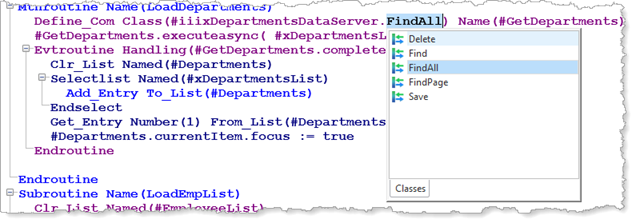
In this step, you will begin to complete your web page logic, firstly by adding logic to initialize the web page. This will include:
1. Copy and paste each of the Group_By and Working list definitions from the Server Modules for files xEmployee and xDepartments and paste them into the Using List Components web page.
2. Create a method routine, named LoadSearchType to perform the following:
Populate the SearchType dropdown with three values, Surname, Given Name and Department.
Position the SearchType dropdown to the first entry and set focus
Set the SearchName edit box to be visible
Hide the Departments dropdown.
Your code should look like the following.
Mthroutine Name(LoadSearchType)
Clr_List Named(#SearchType)
#STD_NAME := 'Surname'
Add_Entry To_List(#SearchType)
#std_name := 'Given Name'
Add_Entry To_List(#SearchType)
#std_name := 'Department'
Add_Entry To_List(#SearchType)
Get_Entry Number(1) From_List(#SearchType)
#SearchType.currentItem.focus := true
#SearchName.visible := true
#Departments.visible := false
Endroutine
3. Create a CreateInstance event routine for the web page, and add code to invoke the LoadSearchTypes method routine.
Evtroutine Handling(#Com_owner.CreateInstance)
#com_self.loadSearchType
Endroutine
4. Complete the ItemGotSelection event routine for the SearchType dropdown, which you created earlier, to display the required input control.
The dropdown SearchType has one column, based on field STD_NAME.
Define a CASE loop for field STD_NAME
Define a When clauses for value 'Surname', 'Given Name' and 'Department'
Within each When clause, make the require control visible and set the other control to Visible=False.
Your code should look like the following:
Evtroutine Handling(#SearchType.ItemGotSelection)
Case Of_Field(#std_name)
When (= 'Surname')
#SearchName.visible := true
#Departments.visible := false
When (= 'Given Name')
#SearchName.visible := True
#Departments.visible := false
When (= 'Department')
#Departments.visible := true
#SearchName.visible := false
Endcase
Endroutine
5. Create a method routine named LoadDepartments.
Note: When completing the following code, if you have the two Server Modules open in the editor, you can easily switch to them, if you wish to review their srvroutine logic.
Remember: The Go To tab is the quickest way to find a routine and position to the code.
Note: Using the AutoComplete prompt as you create the code, lists the srvroutines in a Server Module. For example:

Your routine should perform the following:
Define a component for the xDepartmentsDataServer server module, srvroutine FindAll, named GetDepartments.
Execute GetDepartments asynchronously with parameter list xDepartmentsList.
Within an event routine for GetDepartments.Completed
Selectlist all xDepartmentsList entries
Add each entry to the list component Departments
End Select
Retrieve the first entry in list Departments
Set focus for currentitem
Your code should look like the following:
Mthroutine Name(LoadDepartments)
Define_Com Class(#iiixDepartmentsDataServer.FindAll) Name(#GetDepartments)
#GetDepartments.executeasync(#xDepartmentsList)
Evtroutine Handling(#GetDepartments.completed)
Clr_List Named(#Departments)
Selectlist Named(#xDepartmentsList)
Add_Entry To_List(#Departments)
Endselect
Get_Entry Number(1) From_List(#Departments)
#Departments.currentItem.focus := true
Endroutine
Endroutine
6. In the CreateInstance routine for the web page, add code to invoke the LoadDepartments method routine.
Your code should look like the following:
Evtroutine Handling(#Com_owner.CreateInstance)
#com_self.LoadSearchTypes
#com_self.LoadDepartments
Endroutine
7. Compile your web page.
8. Test your web page.
Select Search Type from the first dropdown. You should then see an edit box for Surname or Given Name search, or a dropdown populated with department descriptions for Departments. There is no other functionality at this stage.